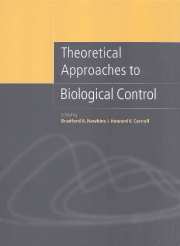Book contents
- Frontmatter
- Contents
- List of contributors
- Preface
- Part I Biological control theory: past and present
- Part II Ecological considerations
- Part III Spatial considerations
- Part IV Genetic/evolutionary considerations
- Part V Microbes and pathogens
- 17 The dynamics of insect–pathogen interactions
- 18 Host–pathogen–parasitoid systems
- 19 Persistence of natural enemies of weeds and insect pests in heterogenous environments
- 20 Application of insect–pathogen models to biological control
- 21 Dose–response relationships in biocontrol of plant disease and their use to define pathogen refuge size
- Index
17 - The dynamics of insect–pathogen interactions
from Part V - Microbes and pathogens
Published online by Cambridge University Press: 13 August 2009
- Frontmatter
- Contents
- List of contributors
- Preface
- Part I Biological control theory: past and present
- Part II Ecological considerations
- Part III Spatial considerations
- Part IV Genetic/evolutionary considerations
- Part V Microbes and pathogens
- 17 The dynamics of insect–pathogen interactions
- 18 Host–pathogen–parasitoid systems
- 19 Persistence of natural enemies of weeds and insect pests in heterogenous environments
- 20 Application of insect–pathogen models to biological control
- 21 Dose–response relationships in biocontrol of plant disease and their use to define pathogen refuge size
- Index
Summary
Introduction
While the potential for insect pathogens to help control pests has long been appreciated, until recently biological control programs have tended to concentrate on predators and parasitoids. Perhaps for this reason, a theory of how predators and parasitoids might regulate the numbers of their hosts was developed as long ago as the 1930s, while what are now considered the classical models of insect–pathogen interactions are barely 15 years old. The last 20 years or so have seen an enormous boom in interest in biological control using insect pathogens, both classical biological control but more especially augmentative biological control and the use of pathogens as bioinsecticides. Part of the reason for the increase in interest in pathogens is the molecular biological revolution that has enabled their natural history to be studied for the first time other than at rather gross anatomical detail. This same revolution has opened the possibility of genetic manipulation of insect pathogens, the relatively simple genomes of many making this a far more realistic prospect than the manipulation of parasitoids or predators.
Biological control is applied population dynamics, and it has always been appreciated that an understanding of the dynamic interactions between pests and their natural enemies will help the efficient implementation of control programs. That being said, there is less agreement about how to set about this exercise, with some pessimists suggesting that the dynamics of natural populations are too contingent to be subject to general theory.
- Type
- Chapter
- Information
- Theoretical Approaches to Biological Control , pp. 307 - 326Publisher: Cambridge University PressPrint publication year: 1999
- 1
- Cited by



